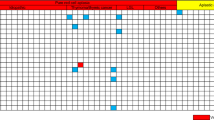Abstract
Persistent infection by parvovirus B19 associated with pure red cell aplasia (PRCA) has been documented in immunocompromised patients. Bone marrow failure is associated with conditions in which immune surveillance is impaired, and in these instances occult parvovirus infection may be suspected. In this study we have assessed by serological and molecular methods whether parvovirus B19 infection may be a more frequent cause of PRCA than hitherto suspected and whether it may be present in the absence of a typical bone marrow picture. Six patients with PRCA — two with isolated PRCA and no apparent underlying disease, two with a lymphoproliferative disease, one with thymoma, and one with chronic myelomonocytic leukemia — have been studied. Four of the six patients had overt PCRA and were clearly immunocompromised. Parvovirus B19 was not detected in any of the six patients by PCR analysis and serology investigating the presence of IgM or IgG antibodies. Although parvovirus B19 infection needs to be ruled out in PRCA it represents only one, and probably not the most frequent, etiological factor of PRCA.
Similar content being viewed by others
References
Belloy M, Morinet F, Blondin G, Courouce AM, Peyrol Y, Vilmur E (1990) Erythroid hypoplasia due to chronic infection with parvovirus B19. N Engl J Med 322:633–634
Carstensen H, Ornvold K, Cohen BJ (1989) Human parvovirus B19 infection associated with prolonged erythroblastopenia in a leukemic child. Pediatr Infect Dis J 8:56
Coulombel L, Morinet F, Mielot F, Tchernia G (1989) Parvovirus infection, leukemia and immunodeficiency. Lancet 1:101–102
Dessypris EN (1991) The biology of pure red cell aplasia. Semin Hematol 28:275–284
Frickhofen N, Abkowitz JL, Safford M, Berry M, Antunez-de-Mayolo J, Astrow A (1990) Persistent parvovirus infection in patients infected with human immunodeficiency virus type 1 (HIV-1): a treatable cause of anemia with AIDS. Ann Intern Med 113:926–933
Frickhofen N, Chen ZJ, Young NS, Cohen BJ, Heimpel H, Abkowitz JL (1994) Parvovirus B19 as a cause of acquired chronic pure red cell aplasia. Br J Haematol 87:818–824
Harris JW (1992) Parvovirus B19 for the hematologist. Am J Hematol 39:119–130
Kurtzman G, Ozawa K, Hanson GR, Cohen B, Oseas R, Young N (1987) Chronic bone marrow failure due to persistent B19 parvovirus infection. N Engl J Med 317:287–294
Kurtzman G, Cohen B, Myers P, Amanullah A, Young N (1988) Persistent parvovirus infection as a cause of severe chronic anemia in children with acute lymphocytic leukemia. Lancet 2:1159–1162
Kurtzman G, Frickhofen N, Kimball J, Jenkins DW, Nienhuis AW, Young NS (1989) Pure red cell aplasia of 10 years' duration due to persistent parvovirus B19 infection and its cure with immunoglobulin therapy. N Engl J Med 321:519–523
Kurtzman GJ, Cohen BJ, Field AM, Oseas R, Blaese M, Young NS (1989) Immune response to B19 parvovirus and an antibody defect in persistent viral infection. J Clin Invest 84:1114–1123
Marmont AM (1991) Therapy of pure red cell aplasia. Semin Hematol 28:285–297
Mintzer D, Reilly R (1987) Pure red cell aplasia associated with human immunodeficiency virus infection: response to intravenous gammaglobulin. Blood 87:124a
Schwarz TF, Roggendorf M, Deinhardt F (1988) Human parvovirus B19: Elisa and immunoblot assays. J Virol Methods 20:155–168
Schwarz TF, Jäger G, Holzgrave W, Roggendorf M (1992) Diagnosis of human parvovirus B19 by polymerase chain reaction. Scand J Infect Dis 24:691–696
Smith MA, Shah NR, Lobel JS, Cera PJ, Gary GW, Anderson LJ (1988) Severe anemia caused by human parvovirus in a leukemia patient on maintenance chemotherapy. Clin Pediatr 27:383–386
Young NS (1991) The pathogenesis and pathophysiology of aplastic anemia. In: Hoffman R, Benz JR, Shattil SJ, Furie B, Cohen HJ (eds) Hematology. Basic principles and practice. Churchill Livingstone, New York, pp 122–160
Weiland HT, Salimans MM, Fibbe WE, Kluin PM, Cohen BJ (1989) Prolonged parvovirus B19 infection with severe anaemia in a bone marrow transplant recipient. Br J Haematol 71:300
Author information
Authors and Affiliations
Rights and permissions
About this article
Cite this article
Gilsanz, F., Garcia Vela, J.A., Vargas, J.A. et al. Acquired pure red cell aplasia: a study of six cases. Ann Hematol 71, 181–183 (1995). https://doi.org/10.1007/BF01910315
Received:
Accepted:
Issue Date:
DOI: https://doi.org/10.1007/BF01910315




